(1) 最適化技術の開発:遺伝的アルゴリズム,実験計画法,多目的最適化など最適化技術開発と最適化プログラム開発
Development of optimization technology: Development of optimization technology and optimization programs such as genetic algorithm, design of experiments, and multi-objective optimization
最適化や最適設計は,あらゆる工学分野と産業に深く関わる大変重要な技術です.SDGsの根源に関わる考え方です.本研究室では,主に機械製品や複合材料構造物などへの適用を研究するとともに,最適化技術の開発も行っています.また,PSO,ACOなど生物界からヒントを得たメタヒューリスティックな新手法の応用や逐次近似最適化法による実用的手法を研究しています.
Optimization and optimal design are very important technologies that are deeply involved in all engineering fields and industries. This way of thinking is related to the fundamental roots of SDGs. In our lab, we mainly study the application to mechanical products and composite material structures in parallel with the development of optimization technologies. We are also studying applications of new metaheuristic methods such as PSO and ACO, which are inspired by biological phenomena, in addition to practical usage of sequential approximation optimization.

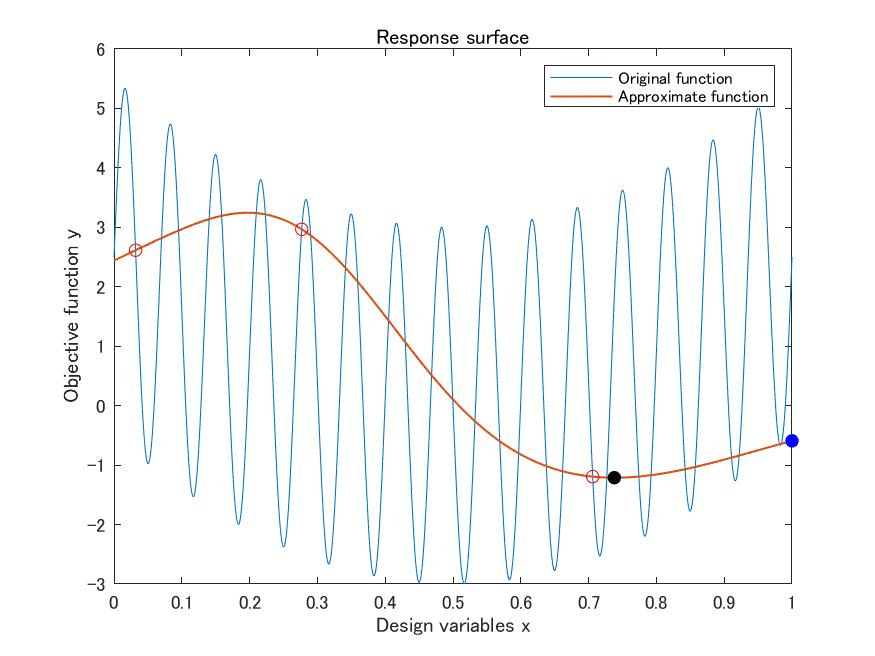
(2) 複合材料構造の強度,振動,座屈などの力学解析: 解析モデルの開発と最適化手法の適用例
Mechanical analysis of composite material structures (strength, vibration, buckling, etc.): Development of analytical models and application examples of optimization methods
炭素繊維強化複合材料(CFRP)は,高い比剛性と比強度の特徴を活用して宇宙航空分野で多用されていますが,近年ではコスト低減が進み,自動車産業へも広く利用が拡大しています.しかし異方性材料を積層するため力学解析が難しく,また構造最適化に適した材料と言われ研究が活発になされながらも,その方法は実用段階より研究レベルに留まるものが多い現状です.
本研究室では,例えば材料異方性を考慮した,様々な解析ソフトおよびモデルを開発し,解析および最適化計算を行っています.また,自然界の材料に着想して,局所的な異方性や,曲線状の強化繊維を持つ複合材料を提案し,その解析手法や最適化手法を開発しています.曲線状の繊維は,従来の直線状の強化繊維を持つ材料よりも,振動数や面内強度の面で優れた機械的性質を示すことが明らかになってきており,機械構造物の高性能化に貢献できます.
Carbon fiber reinforced composite material (CFRP) is widely used in the aerospace field due to its high specific rigidity and strength, but in recent years, cost reduction has progressed, and its use has expanded widely into the automobile industry. However, it is difficult to analyze the dynamic behavior due to its anisotropic material properties caused by lamination. Although these materials are suitable for structural optimization and research is being actively carried out, many of these methods remain at the research level and yet to reach the practical stage.
In our laboratory, for example, we develop various analysis software and models considering material anisotropy and perform analysis and optimization calculations. Inspired by natural materials, we propose composite materials with local anisotropy and curved reinforcing fibers and develop specific analytical methods and optimization techniques. It has become clear that curved fibers exhibit superior mechanical properties in terms of frequency and in-plane strength compared to conventional materials with linear reinforcing fibers. Thus, improving the performance in mechanical structures.

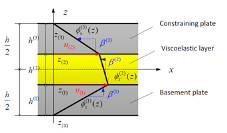
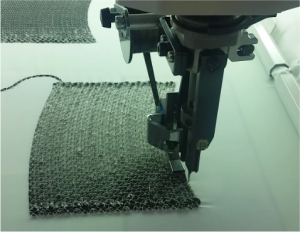
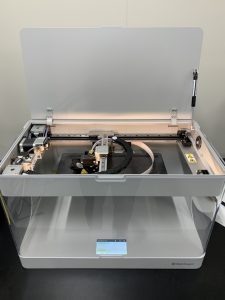
(3) 電着樹脂含浸法を用いた新たな複合材料の作製方法の開発と性能評価 / Development and performance evaluation of a new composite material fabrication method using electrodeposition resin impregnation method
電着樹脂含浸法は,電着技術を援用した炭素繊維プリフォームへの樹脂含浸手法である.電着技術はもともと防錆を目的として,自動車車体の下地塗装として用いられてきた技術であり,その他には建材の塗装,装飾用塗装,電子材料分野で活用されている.本研究ではファイバー縫い付け機によるTFP技術 (Tailored Fiber Placement)を用いて作製した樹脂が未含浸のプリフォームに,電着樹脂含浸法を用いて樹脂を含浸することでCFRP積層板を作製している.電着樹脂含浸法の概略を以下に示す.エポキシ基を含む電解液にプリフォームを浸し,プリフォームを陰極,ステンレスワイヤを陽極として通電することで炭素繊維の表面にエポキシ樹脂を析出させ,樹脂を含浸させる.
Electrodeposition resin molding is a method of impregnating carbon fiber preforms with resin using electrodeposition technology. Electrodeposition technology was originally used as a base coating for automobile bodies to prevent rust and is also utilized in the fields of building materials, decorative coatings, and electronic materials. In this study, CFRP laminates are fabricated by impregnating resin using an electrodeposition resin impregnation method on preforms that have not been impregnated with resin, which are fabricated using TFP technology (Tailored Fiber Placement) with a fiber stitching machine. A schematic of the electrodeposition resin molding method is shown below. The preform is immersed in an electrolytic solution containing epoxy groups, and the resin is impregnated by depositing epoxy resin on the surface of the carbon fiber by passing electricity through the preform as a cathode and the stainless wire as an anode.
VaRTM法などに代表されるリキッドレジンモールディング成形法では圧力を用いて樹脂を繊維間に押し込み,樹脂を含浸させる.一方,電着樹脂含浸法では,電気化学的に樹脂を炭素繊維表面に析出させるため,ボイドが発生しにくい.また,樹脂の流動を伴わないため,曲線状の繊維形状を乱さないという点などが挙げられる.そのため,曲線状に繊維を配向したプリフォームを作製することのできるTFP技術と相性が良い.また,通電後,電着液から引き上げた後はまだ完全に硬化しておらず粘着性を有するため,型を用いて成形することで,曲面成形することや一体成形することが可能であり,成形自由度が高い.
Liquid resin molding methods, such as the VaRTM method, use pressure to press resin between fibers to impregnate them. On the other hand, the electrodeposition resin impregnation method electrochemically deposits resin on the surface of carbon fibers, which prevents the formation of voids. In addition, because the resin does not flow, the curved fiber shape is not disturbed. This makes it compatible with TFP technology, which can produce preforms with curvilinearly oriented fibers. After the electrodeposition solution is removed from the electrodeposition solution, the material is not fully cured and still has adhesive properties, so it can be molded with a mold to form curved surfaces or as a single piece.
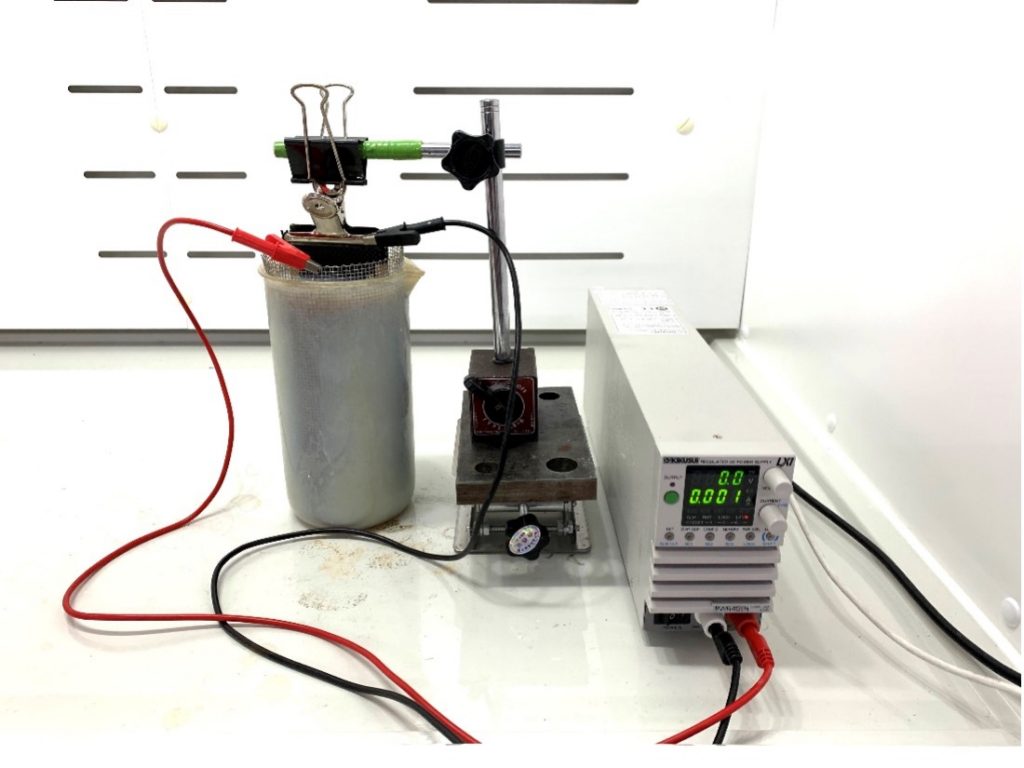

(4) カスタムメードステントの最適形状設計
Optimal shape design of custom-made stent
人口構成の高年齢化により,高脂血症などによる血管狭窄,癌などによる気管や尿道の狭窄が増えています.その治療には生体内ストレッチャの一つであるステントが用いられます.ステントは主に金属を材料とする網目構造を持ち,狭窄部に挿入された後に拡張し狭窄部を取り除きます.既製ステントは規格化され狭窄状態の個人差を考慮することができませんでした.しかし複雑な部位へは狭窄形状を考慮したテーラーメイド設計が必要です.このためには,ステントの構造と変形との関係を明確にし,ステントの変形をその構造から制御する手法が必要です.本研究室では,バルーン拡張型ステントおよび自己拡張ステントを任意に変形させる手法を開発するため,有限要素解析やトポロジー最適化手法を駆使し,より優れたステントを設計し、3Dプリンターによる製作まで行うためのシステムの構築を行っています。
Due to the aging of the population, vascular stenosis due to hyperlipidemia and tracheal and urethral stenosis due to cancer are increasing. A stent, which is one of the in-vivo stretchers, is used for the treatment. The stent has a network structure mainly made of metal, and after being inserted into the stenosis, it expands and removes the stenosis. Conventional stents are standardized and cannot take into account individual differences in stenotic conditions. However, for complicated conditions, a tailor-made design considering the shape of the stenosis is more suitable. For this purpose, it is necessary to clarify the relationship between the structure of the stent and its deformation and to control the deformation of the stent from that structure. In our laboratory, to develop a method for arbitrarily deforming balloon-expandable stents and self-expanding stents, we make full use of finite element analysis and topology optimization methods. Through these processes, we are able to design better stents and even manufacture them with a 3D printer.

(5) 粘塑性構成モデルによる電子実装基板の接続部の強度解析
Strength analysis of electronic package connectors by using an visco-elastic constitutive model
本研究では,小型化・複雑化されたパッケージの安全性・信頼性を保つ設計のために,それぞれの構成材料のマイクロレベルでの組織状態および強度評価とサブマイクロサイズでの強度評価,および,パッケージ全体を一つの複合材料と捉えた等価複合モデルによるマクロサイズでの強度評価を融合したマルチレベルデザインによる最適構造解析手法の構築を目指しています.また,このためには,はんだ接続部の正確な変形特性を解析する必要があります.このために,マイクロインデンテーションによる粘塑性変形の解明を行い,さらに,弾塑性クリープ分離型モデルや転位密度型構成モデルを用いてそれらの変形特性を記述することを試みています.構成モデルで使用される材料パラメータを粒子群最適化や遺伝的アルゴリズムを用いて効率的に定める手法についても検討しています.
In this study, in order to maintain the safety and reliability of miniaturized and complicated electronic packages, the microstructure and strength evaluation of each constituent material at the micro-level, and sub-micro level are required. We are aiming to build an optimal structural analysis method by a multi-level design that integrates strength evaluation at macro size by an equivalent composite model that regards the entire package as one composite material. For this purpose, it is necessary to analyze the accurate deformation characteristics of the solder connections. For this purpose, we are trying to clarify the viscoplastic deformation by micro indentation and describe the deformation characteristics using an elasto-plastic creep separation type model and the dislocation density type constitutive model. We are also investigating a method for efficiently determining the material parameters used in the constitutive model using particle swarm optimization and genetic algorithms.
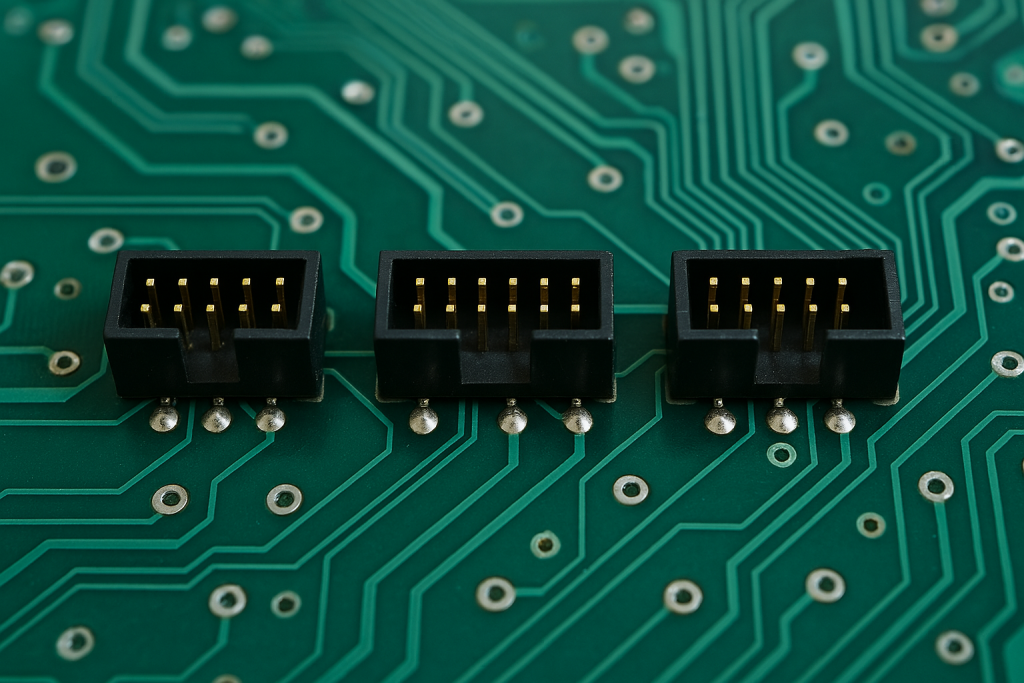
(6) 大動脈および冠動脈の血流解析
Blood flow analysis of aorta and coronary arteries
社会の高齢化により血管疾患,特に大動脈瘤や動脈硬化などを患う高齢者が増えてきている.これらの疾患は自覚症状が出て素早く処置することが重要となる.そこで本研究では.大動脈瘤および動脈硬化のCT画像から血管のモデル化,血流解析,解析結果による診断までを素早くスムーズに行うためのシステムの構築を行っている.解析にはオープンソースソフトウェア―(OpenFoam,Elmer等)を主に使用することによる経費の削減も視野に入っている.特に,流体と血管構造変化の流体ー構造連成解析(FSI解析)を行うことにより,より高精度の診断に役立てることを目指している.
Due to the aging of society, the number of elderly people suffering from vascular diseases, especially aortic aneurysms and arteriosclerosis, are increasing. It is important to treat these diseases promptly with subjective symptoms. Therefore, in this study, we are constructing a system that can quickly and smoothly diagnose aortic aneurysm and arteriosclerosis, through blood vessel modeling, blood flow analysis based on medical CT images. We are also considering cost reduction by mainly using open source software (OpenFoam, Elmer, etc.) for analysis. In particular, we aim to use it for more accurate diagnosis by performing fluid-structure coupled analysis (FSI analysis) of fluid and vascular structural changes.
(7)機械学習を用いた塑性加工不具合同定システムの開発
Development of plastic working defect identification system using machine learning
鍛造は短時間に多くの製品を作製可能であることから産業界で広く行われている.しかし,型の不具合などから不良品が発生すると大損害になる可能性がある.このため,不良品発生を作業中に予め予測できれば不良品の発生を最小限に抑えることが可能となる.そこで本研究では,機械学習を用いた鍛造時の不良品予測システムの構築を行う.また,同時にバリの発生予測も行い,バリ発生と不良品との相互関係についても検討する.
Forging is widely used in the industrial world because many products can be produced in a short amount of time. However, if there is a defect in the mold, it lead a large number of defective products. Therefore, if this defect can be predicted in advance during the forging process, the number of defective products can be minimized. Therefore, in this research, we constructed a defective product prediction system during forging using machine learning (ML). At the same time, the occurrence of burrs is predicted, and the interrelationship between the occurrence of burrs and defective products was also examined.
(8) 臨床応用を目的とした膝関節安定性に関する研究
Research on knee joint stability for clinical application
膝は体内で最も負荷がかかり,損傷しやすい関節である.スポーツや怪我による力学的な異常は変形性関節症(OA)等の慢性疾患につながる可能性が高い.そのため,新たな治療法の開発は,生体工学および整形外科の分野で大きな課題となっている.定量的に膝関節の力学特性を測定することは,関節内の各組織の役割を知る上で極めて重要な項目である.したがって,本プロジェクトの目的は,膝関節の力学的特性を定量的に評価するための新技術を開発することである.
The knee is the most stressed and vulnerable joint in the body. Mechanical abnormalities due to sports and injuries are likely to lead to chronic illnesses such as osteoarthritis (OA). Therefore, the development of new treatments has become a major issue in the fields of bioengineering and orthopedics. Quantitative measurement of the mechanical properties of the knee joint is an extremely important criterion for understanding the role of each tissue in the joint. Therefore, the purpose of this project is to develop a new technique for quantitatively evaluating the mechanical properties of the knee joint.
